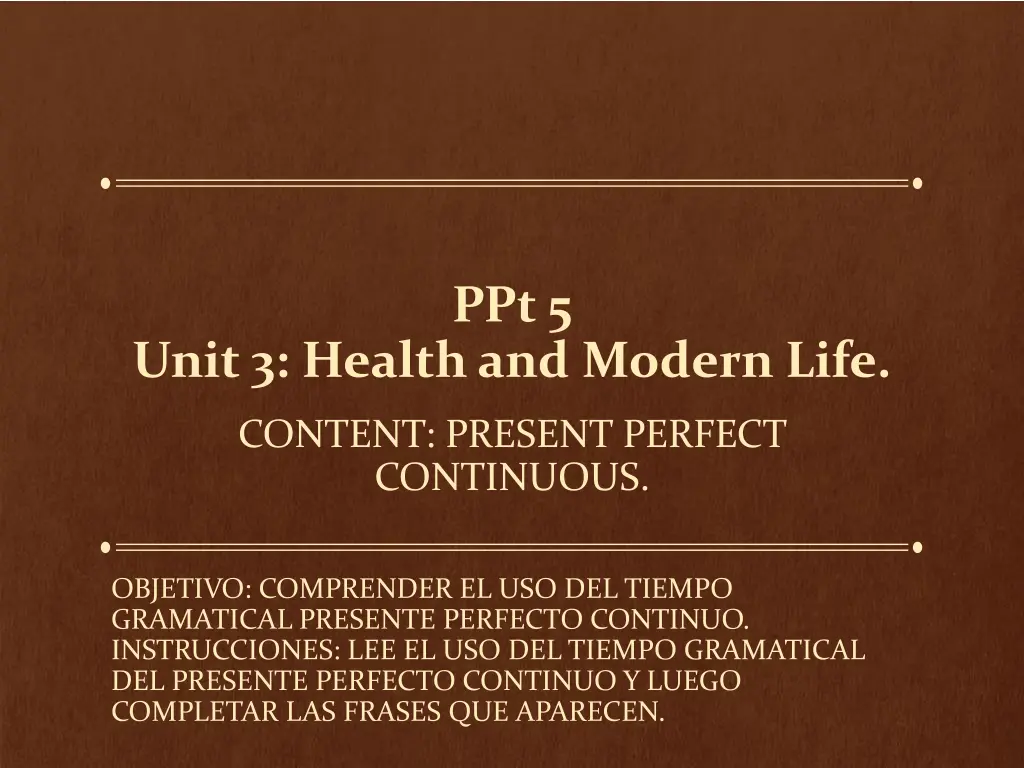
Understanding Present Perfect Continuous Tense
Learn the usage of the Present Perfect Continuous tense and complete phrases to practice. Understand how to construct affirmative, negative, and interrogative sentences in this tense. Explore examples to grasp the concept effectively.
Download Presentation

Please find below an Image/Link to download the presentation.
The content on the website is provided AS IS for your information and personal use only. It may not be sold, licensed, or shared on other websites without obtaining consent from the author. If you encounter any issues during the download, it is possible that the publisher has removed the file from their server.
You are allowed to download the files provided on this website for personal or commercial use, subject to the condition that they are used lawfully. All files are the property of their respective owners.
The content on the website is provided AS IS for your information and personal use only. It may not be sold, licensed, or shared on other websites without obtaining consent from the author.
E N D
Presentation Transcript
PPt 5 Unit 3: Health and Modern Life. CONTENT: PRESENT PERFECT CONTINUOUS. OBJETIVO: COMPRENDER EL USO DEL TIEMPO GRAMATICAL PRESENTE PERFECTO CONTINUO. INSTRUCCIONES: LEE EL USO DEL TIEMPO GRAMATICAL DEL PRESENTE PERFECTO CONTINUO Y LUEGO COMPLETAR LAS FRASES QUE APARECEN.
WHAT CAN WE UNDERSTAND ABOUT THIS TENSE, JUST BY MENTIONING ITS NAME? Present Perfect Continuous Present Perfect Present Continuous
PRESENT CONTINUOUS REMEMBER AFFIRMATIVE SUBJECT + VERB TO BE + VERB (ING) + OBJECT NEGATIVE SUBJECT + VERB TO BE + NOT + VERB (ING) + OBJECT INTERROGATIVE VERB TO BE + SUBJECT + VERB (ING) + OBJECT + ?
PRESENT PERFECT REMEMBER AFFIRMATIVE SUBJECT + HAVE/HAS + PAST PARTICIPLE + OBJECT NEGATIVE SUBJECT + HAVE/HAS + NOT + PAST PARTICIPLE + OBJECT INTERROGATIVE HAVE/HAS + SUBJECT + PAST PARTICIPLE + OBJECT + ?
PRESENT PERFECT CONTINUOUS STRUCTURE AND MEANING
PRESENT PERFECT CONTINUOUS She has been working at that company for three years. Mary has been feeling a little depressed. We use the Present Perfect Continuous to show that something started in the past and has continued up until now. "For five minutes," "for two weeks," and "since Tuesday" are all durations which can be used with the Present Perfect Continuous. to emphasize this meaning. You can also use the Present Perfect Continuous WITHOUT a duration such as "for two weeks." Without the duration, the tense has a more general meaning of "lately." We often use the words "lately" or "recently"
PRESENT PERFECT CONTINUOUS STRUCTURE AFFIRMATIVE SUBJECT + HAVE/HAS BEEN + VERB (ING) + OBJECT NEGATIVE SUBJECT + HAVE/HAS BEEN + NOT + VERB (ING) + OBJECT INTERROGATIVE HAVE/HAS + SUBJECT + BEEN + VERB (ING) + OBJECT + ?
CHECK THE NEXT EXAMPLES WITH THE USE OF THE PRESENT PERFECT CONTINUOUS TENSE
EXAMPLES: Lisa has not been practicing her English.
EXAMPLES: They have been talking for the last hour.
EXAMPLES: Have you been exercising lately?
NOW ITS TIME TO PRACTICE TOGETHER THE USE OF THE PRESENT PERFECT CONTINUOUS TENSE
MAKE THE PRESENT PERFECT CONTINUOUS TENSE Check the form have not been visiting has been learning - We (live) in London forsix months. ? - She (learn) English for two years. been visiting Has He (visit) Europe a few weeks ago. have not been sleeping You (sleep) for twelve hours. have been exercising I (exercise) in thegym for half an hour.
